Tips On Building Your First Horse Farm
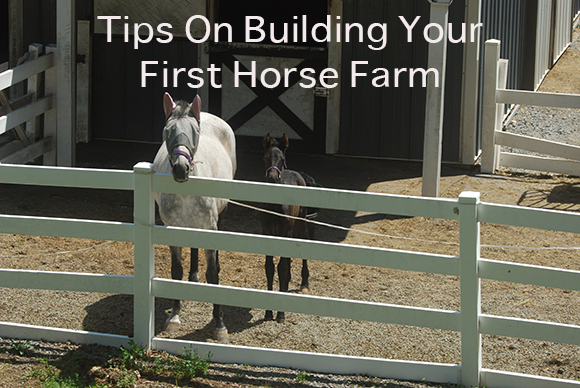
Do you dream of finding the perfect place to develop your own equestrian paradise? Perhaps you’ve thought of opening a horse training/boarding business, a dude ranch, or simply want to keep your own horses at home instead of at livery. Perhaps you picture yourself riding the trails or perfecting your dressage work.
Most horse folks eventually arrive at the determination that keeping their horses themselves would be a perfect life. The first thing to consider is the ultimate purpose of the farm. If you haven’t bought property yet then here are a few things to consider. We’ll also look at development of your existing property.
The ideal property will be good tillable land with rolling hills or flat land and most importantly it needs to have good drainage. Beware of buying land split by a road crossing a busy road with horses is not a sound idea. Regardless of what signage the county will put out there drivers are often not very obliging about heeding the warnings and slowing down.
You’ll need to allow adequate space for the development of a commercial project. For example, people often forget that boarding barns with 40 stalls can mean 40 cars to park, 40 people and their families/friends using bathroom facilities and some amount of noise with this traffic. So plan for that when you design the facility if you are thinking of going the boarding route.
The layout of the buildings and paddocks is important and if you are lucky enough to have a large and fairly level surface then you have the opportunity to design it to perfection for daily use.
If you build your barn, with possibly an attached indoor or an outside arena on a level field you would be able to place it in the center and have the paddocks extending all around with some parking in the front. The placing of paddocks is very important. You do not want to be walking horses long distances for turn out and whether you are setting up a horse breeding operation and will be leading mares and foals in and out, or have boarders visiting, no-one wants to be taking extensive walks in all weathers just to fetch their horses. It is also a sensible idea to leave a swath of grass (i.e. double fence) between fence lines so horses cannot reach out to each other and argue over the fence. This can result in damage to both the horses and the fences.
Keeping the pastures close to the barn will also allow a less expensive provision of running water to the troughs in the fields. You will probably want to drill a well for the barn’s exclusive use to service both water in the barn, and the bathroom facility you will surely want to have there. A quick piece of advice: If possible use a Pex product, a plastic pipe that expands if it freezes versus copper where you can.
When choosing the site for your barn the direction of the sun is important for both light and warmth. Also consider the prevailing wind direction. This will also affect how you place run in sheds for the pastures. A run in shed should always have its back to the prevailing wind and not be located at the lowest part of the pasture where water will constantly drain into it, and if possible add some gravel through gateways and in front and under the shed to keep these area from becoming muddy.
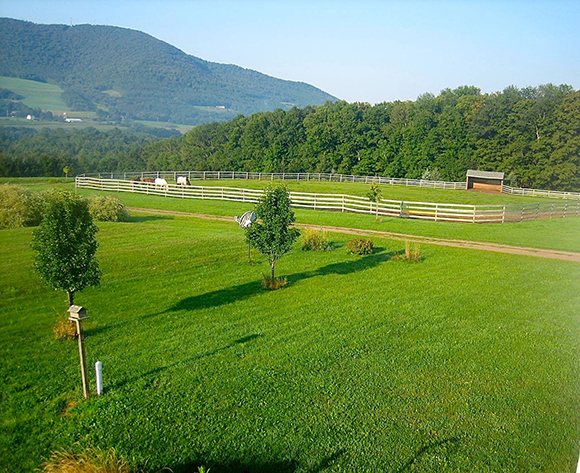
Barn design should include areas for tack, feed and hay storage, shavings or bedding storage, possibly a wash stall, and address good air circulation. Also consider safety. The aisle-ways should be wide enough for two horses to safely pass each other, the stall walls should be solidly divided (especially if you are thinking of a boarding operation-these types of walls will 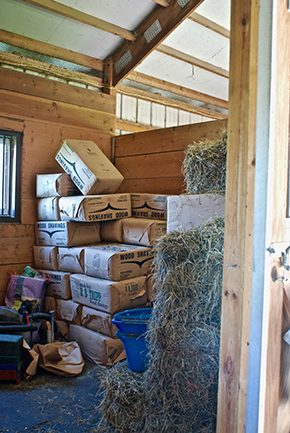 make it so that horses cannot intimidate each other) and stall grills high enough to ensure that youngsters don’t put a foot through them. Floors should have drainage, so they can be properly disinfected. Poor air quality in barns is caused by general lack of ventilation, unsanitary bedding and poor stall maintenance, and overhead hay storage. All these issues can contribute to respiratory disease in horses. The stalls should also be matted to protect the horse’s joints and complete the easy maintenance. Sliding door systems are better than doors that open into the aisle way as they are safer and tidier in appearance. Also consider if you have Dutch doors that open to the outside, it is important to have some sort of roof overhang to protect the horses from the hot sun and windy/rainy weather. These doors in particular should be high enough to be safe. Many horses dive over stall doors and get hurt so be aware of this possibility.
make it so that horses cannot intimidate each other) and stall grills high enough to ensure that youngsters don’t put a foot through them. Floors should have drainage, so they can be properly disinfected. Poor air quality in barns is caused by general lack of ventilation, unsanitary bedding and poor stall maintenance, and overhead hay storage. All these issues can contribute to respiratory disease in horses. The stalls should also be matted to protect the horse’s joints and complete the easy maintenance. Sliding door systems are better than doors that open into the aisle way as they are safer and tidier in appearance. Also consider if you have Dutch doors that open to the outside, it is important to have some sort of roof overhang to protect the horses from the hot sun and windy/rainy weather. These doors in particular should be high enough to be safe. Many horses dive over stall doors and get hurt so be aware of this possibility.
When designing the barn also think about the lighting. This will also affect the placement of the outdoor arena if you want one and if you think you might want to light it. It is a good idea to have a separate meter for the barn/indoor if you are operating it as a business, from both a billing standpoint and in case you want to offer the facility for lease to a trainer at a later time.
There are many options for barn building from the popular prefabricated modular construction, which is on site and set and ready to go in just a few days to the traditional pole build. Be sure you compare apples to apples when comparing prices.
For fencing your pastures there are many options. The cheapest but not necessarily the safest or the best looking is electric tape or rope. There are maintenance free options such as PVC and other manmade products and then there is traditional board fencing. Land that is level and has a good topsoil base with good drainage will make life a lot easier when it comes to fence installation.
It is also a good idea to add a gate at the end of your driveway so you can secure the horses within your property when necessary. Fencing the perimeter is a good safety addition.
So now your horses are safely housed and grazed it’s time to think about what you want to do with them. Many folks just get out and trail ride. From an investment standpoint, and a training standpoint, some sort of outside arena is paramount and the most important is factor in an arena is the footing. Footing mistakes can be costly. Also be aware that products that are rubber based when used have been found to affect both horse and rider by small particles of rubber entering their respective lungs. For the arena you should also consider how you are going to water it, drain it and it should always be fenced for safety.
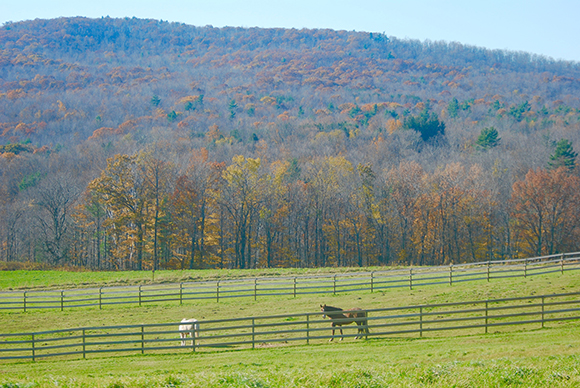
Now you have built this amazing dream property you need to consider how you are going to maintain it. You will need a tractor or some type of hauling equipment for manure, a harrow for the arena and also consider how and where you are going to dispose of the manure. You can set up a concrete bunker (not too close to the barn because of the flies/insect issue and smell but also not too far away for winter use), the advantage of this is you can compost it and then spread it at a later date over the fields or garden. One innovative barn I know sells their manure to a large supermarket that supplies the trailer for its deposit and then picks it up and delivers it for use to their own vegetable farm. Recycling is always good!
This equipment will also require some kind of storage. So add a building for that.
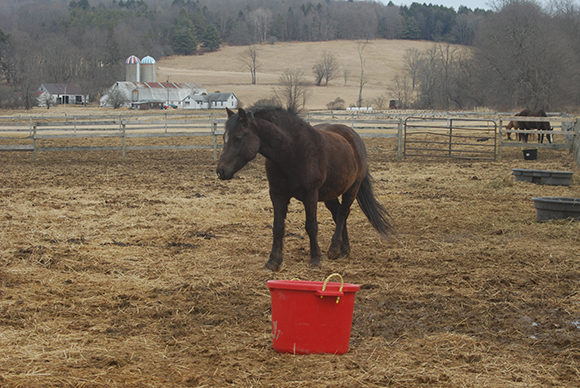
You should also consider security and proximity of the barn to your home. It is wonderful to wake up and view horses contentedly grazing in the meadow from the bedroom window. However, horses bring with them horse manure and flies. It may therefore be prudent to place your barn a distance from the back porch.
Additionally you should consider the security of the horses. If you are running a boarding operation do you want to see every car or truck that makes a visit? There is a trade off between privacy and security that you’ll need to consider.
Happy Riding!
About the author: Nikki Alvin-Smith is an international Grand Prix dressage trainer/clinician who has competed in Europe at the Grand Prix level earning scores of over 72%. Together with her husband Paul, who is also a Grand Prix rider, they operate a private horse breeding/training farm in Stamford, NY


